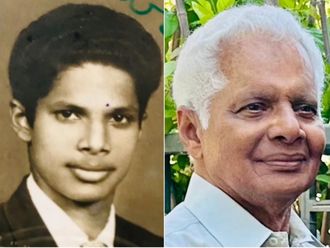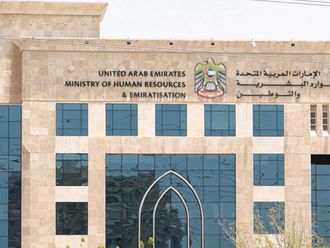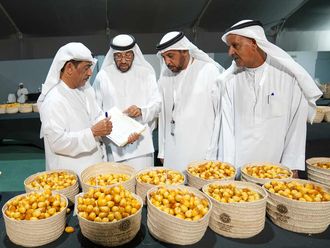Faisal Laibi Sahi |
In his exhibition that opened at the Abu Dhabi Cultural Foundation on Sunday, Iraqi artist Faisal Laibi Sahi is presenting more than 40 years of his work in the field of art. His paintings showcase multiple stages and different art styles he has experimented during his four decades as an artist.
In the exhibition, which continues till January 28, there are 135 paintings of all sizes, from the miniature to the expansive. A few acrylics and oils on large-sized canvasses, a few inks on paper and other oils and watercolours make up a series focussing on the suffering of the Iraqi people.
Portraits, even replicas, of the ancient hieroglyphic tablets of Mesopotamia and cartoons of famous personalities, writers and poets form part of the exhibition as well.
Says Sahi in an interview: "I've tried to show a representation of 40 years of my work. I've tried to select paintings from each stage of my work."
An entire series of paintings reflects the pain and oppression experienced by his countrymen. The paintings depict people carrying dead bodies wrapped in white, headless bodies and faces contorted as if in pain. If they tend to be dramatic, he explains they are meant to drive home the "apocalypse", he feels his country is undergoing.
Faisal Laibi Sahi left his country in 1974 and is now based in London. Born in the Iraqi city of Basra in 1947, he completed his diploma in painting from the Institute of Fine Arts in Baghdad and gained a further diploma from the Academy of Fine Arts, University of Baghdad.
Sahi has also obtained a diploma from Paris from the University of Sorbonne and the 'Ecole Superieure des Beaux-Arte de Paris' as well. After living in Algeria, Italy and France, he has set up base in England for the past 10 years.
Yet, his memories linger around his birthplace - Basra - an often-repeated theme in his work. And a visitor to his exhibition can also come across a collection of small paintings about the streets and architecture of Baghdad, including one on the Haider Khana mosque.
Not being rooted in one style, there is no single thread of continuity in his exhibition. You can suddenly come across a few canvasses on the ancient script of Mesopotamia, right beside a few cartoons. He describes these works as "a piece of music in colour, not in voice".
"What I'd like to be known as is an eastern artist," he states firmly. Many years ago he felt the need to highlight his own rich artistic heritage and has stuck to it since. "In England, each gallery promoted its own school of thought or style," he explains. "But I often exhibit at the Kufa gallery in London," says this artist, who has held plenty of solo and group exhibitions in Italy, Algeria, Germany, Syria, England and Belgium.
His portraits and his cartoons of various personalities, like satirical writers and poets, and of people in general, are extremely rivetting. An example being a work titled Moonlight, which shows a woman in red holding a bunch of grapes. He also has an entire cartoon series on famous people of the region, including Badr Shaer Al Sayeb, Ghazi and Abu Sayeed, among others.
If you ask him about the school of art he subscribes to, Sahi replies: "Life is a good school by itself, I should think."











